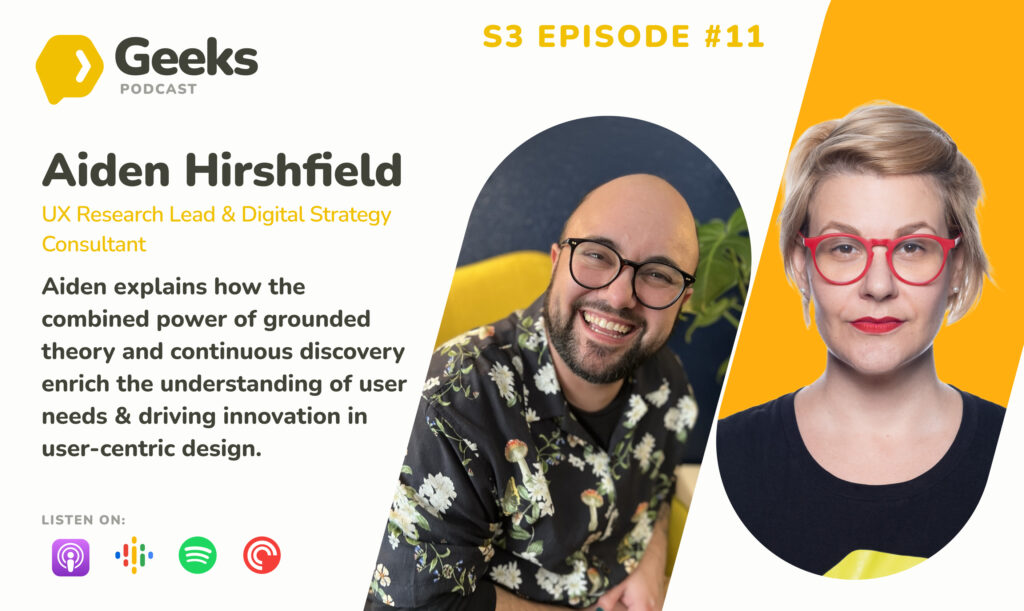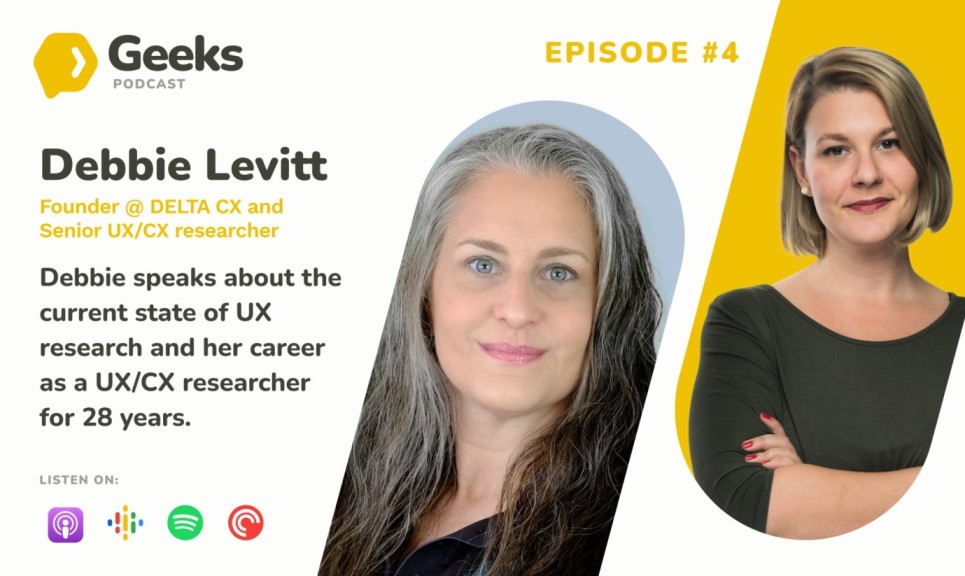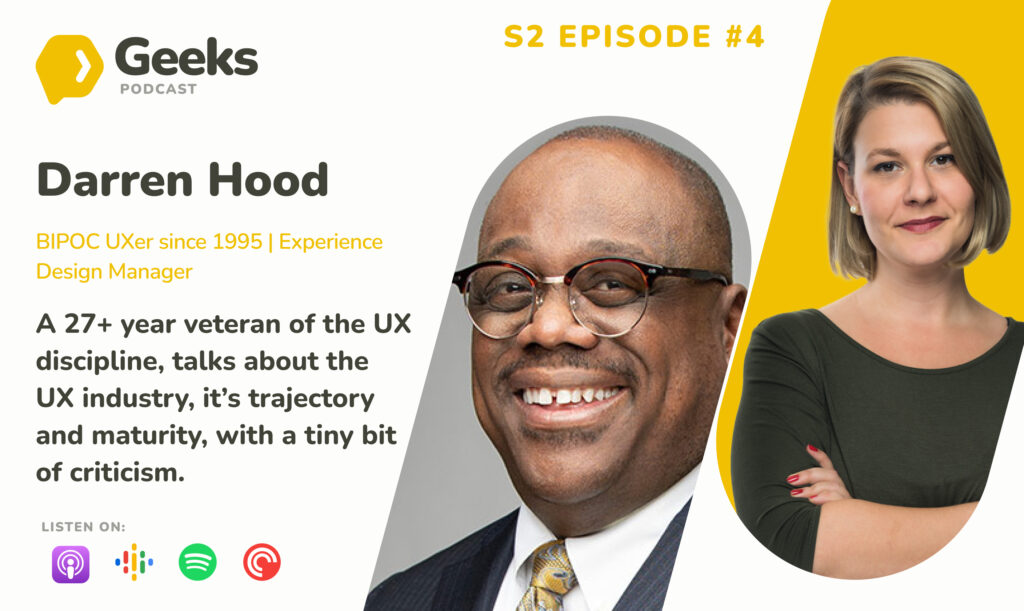Episode highlights
- 00:01:20 Suj’s Transition from Recruitment to UX
- 00:05:34 Innovative UX Education for Children
- 00:10:19 The Impact of Meditation and Mindfulness
- 00:15:01 Choosing UX as an Educational Tool
- 00:22:09 Podcast Episode Wrap-Up
About our guest Suj Premachandran
Suj Premachandran has a varied career, with roles at Salt, Revolut, and Fitness First UK. He holds degrees from the University of the Arts London and London South Bank University. Now the CEO of Digital Influx Academy, Suj is recognized for his organizational ability, tech skills and adaptability.
Podcast transcript
[00:00:00] Tina Ličková:
Welcome to UX Research Geeks, where we geek out with researchers from all around the world on topics they are passionate about. I’m your host Tina Ličková, a researcher and a strategist, and this podcast is brought to you by UXtweak, an all-in-one UX research tool.
This is the 10th episode of the third season of UXR Geeks. In this episode, I’m joined by Suj who is changing the game by teaching kids UX design. He believes in mixing design with empathy to help the next generation think differently. We hear about Suj’s journey, the impact of his work and why it matters.
In this episode, we focus on how design can and is linked to spirituality even more than you would think.
Before we go into the curriculum and what’s cool and what you guys do, what you do, can you tell me more of your story because when I was spying on you on LinkedIn. I found out you were in talent acquisition of designers and this is, and I am interested, like, how did you end up doing that and how did you then switch to a founder?
[00:01:20] Suj Premachandran: I was born in India in a place called Kerala and I moved to the UK when I was like five and I got to experience education in the East and in the West, which was pretty interesting. Picked it up fairly quickly. And I studied at the university of arts. Which is a fairly creative place. I studied creative advertising.
So I was exposed to portfolios from universities. I was always looking at this kind of artwork and unfortunately I couldn’t get a job in advertising because I came out of union to the last recession. I was like, shit, what am I going to do? And ended up falling into recruitment. Like a lot of people do. The first company I worked in, I did really well, made quite good money.
And then one day I was just like, I’m going to quit. I was like, I’ve got money in the bank, let’s do what I want. So I went traveling for a bit and then wanted to do something to help kids, but I couldn’t really figure out what to do. And then I came back and started working within UX recruitment. And it was while I was working in UX recruitment that I had this brainwave, right, which was essentially, we’re always looking for people, any recruitment companies, always looking for people, forever.
But they’re looking for people like this because the pipeline doesn’t start sooner. We’re not teaching skills that are relevant for the workplace in school, but technology is moving so quickly, like AI, as an example. Taking away jobs, these actors in Hollywood are striking. They weren’t expecting this to happen, right?
They’re scanning their faces and bodies and losing their likeness forever. That wasn’t a thing like five years ago. And what I started doing was I started studying UX while I was doing the recruitment part of it. That’s when I realized that the central thesis around design and UX is empathy. Right.
Understanding each other, understanding people, understanding our environment. And children to me are the most empathetic people in the world. Gimmicks in there. Like they’re not racist or sexist or worrying about wealth. And that’s where it came to come about. My like ethos and life, even though I was working in recruitment, I was never really like a full on recruiter.
I was looking for something. And once I found it, I was like, I work in recruitment. I’m speaking to all of these people, right? Product managers, CEOs, CTOs. I just started asking questions. I was like, Oh, how do you do this? How do you do that? How do you do this? Then I was like, Oh, okay. Thanks for all of this.
Now I’ll just amalgamate all this information and just start a company. And that’s what I did.
[00:03:58] Tina Ličková: And the company’s Digital Influx, or you started a different company?
[00:04:02] Suj Premachandran: We started in a way to help us grow. So I knew from working with startups and recruitment that all these startups are always struggling for money, right?
They’re always struggling. They’re always looking for investment. I also knew that the statistic for diverse founders, so essentially if you’re a woman or you’re a person of color, you’ve got 3 percent of the population. Of the global venture capital of the world. That’s pretty much it. That’s what you’re given.
So I was like, screw this. So we started the company as a recruitment company first generate around 300, 000 by ourselves and then move into ed tech. That was the plan. And it was working right. Like we made around a hundred grand in our first year. I was like, all right, let’s do it. I would use my skills and do it ourselves.
But then that thing called the pandemic happened, right? And I was like, yeah, what do we do now? And I thought, let’s just capitalize on this because everyone’s at home. The teachers, the parents, the kids, it’s probably the best time in the world to do user testing. And we did it. And as soon as I did it, I was like, I’m starting to understand the dynamics of running a startup from home.
And we grew it, like we created this curriculum. Then we started testing it with students and then we started selling it. Still can’t get any funding, but managed to become. The world’s leading provider of UX education.
[00:05:34] Tina Ličková: When you are providing UX education, what does it mean? Because there is a lot out there.
I don’t want to name others, but there is a lot of education and there is a lot of criticism also coming from people who, I don’t know, where in academia or. Where studying human computer interaction and working their ass off to study. And then somebody comes from a bootcamp, and I know a UX designer, why did you wanna step into this space?
You set the pandemic and everything, but what? How is it different?
[00:06:09] Suj Premachandran: So our courses are aimed at children, right? The boot camps that are out there, they’re made and mostly aimed at adults. There’s no curriculum essentially set for the demographic that we’re going after. We are going to be moving into the bootcamp space this year.
Yeah, I saw it. Yeah, but essentially the way we’ve looked at it is that my background as a recruiter working with companies. When I’m working with them, but being exposed to companies like General Assembly, as an example, the feedback that I would get from my time as a recruiter was the same thing that you’re saying.
And they’ve got the same portfolio as five other people that have done the same bootcamp, and that was problematic. And it was obviously horrible for them. But for me, I was like, this is good. I’m like, I can see what not to do, which is a good thing. And once we created the curriculum for the children. I started looking at how can we use the research with the kids to create a leading bootcamp, like something that’s completely different from everyone else.
And we’ve worked on something that’s essentially focused on. Job placement and portfolio creation. So we work with the United Nations sustainable development goals. I don’t know if you’ve heard of the 17 goals. Yeah. Yeah. So I think they’re all great goals, right? But I don’t think the governments of the world are going to spend enough time or money.
In those goals to solve the problems in the time we have left on earth, right? So we get the children to create solutions around it. That’s what we started with the kids course, but then we use the same model to move in for the adults. Our course right now, the first module is, is two modules. It’s split between us research and UX design.
This is, again, is coming back from my feedback as a recruiter. A lot of the times that people go into these bootcamps, they’re given a All of the skills straight away, right? Learn how to design, learn how to wireframe, do this, do that. I think that’s the wrong way to do it. I think you need two months completely focused on UX research, so you understand the psychology of the user.
Then once you completely understand people, then you learn the design tools. That’s one of the differences that we completely focus on. The second part is that we utilize Something called Vedic education, which is an ancient form of education from India. And essentially, me being Indian, I wanted to do something that connects to my roots.
And the Vedic education framework was essentially focused on yoga, meditation, the karmic way of looking at things, having balance within yourself. And this is something that was taught like thousands of years ago. But the central thesis again is looking at empathy and what’s happened now is people are selling it.
Like the stuff that we created, right, is now being sold on an app. Do some yoga, do this, do that, mindfulness, breath work, that all comes from the Vedic era. That’s not new. And what we’re doing is we’re integrating elements of this into our course. So what happens if before you do your wireframes, you do 10 minutes of breath work?
What happens if you do yoga before doing a group session? Now we don’t need to like officially test this kind of stuff because it’s already been tested people know it works Right, so we’re integrating elements of that into the course as well And then once we’ve done the first iteration of this particular boot camp, we’re going to be looking at integrating other elements of the Vedic framework into it as well around user research and psychology to approach people from a different angle.
This is also to combat what’s happening with AI, how we’re going to differentiate ourselves from the machine. AI can do things quicker than most people, right? Even in the creative space now, like. You can do things, you can write songs, you can do whatever the hell you want. But how do we differentiate ourselves?
And that is how we’re doing it. We’re using this framework of education from the past to create a new way of thinking for design.
[00:10:19] Tina Ličková: One of the biggest inputs for my personal life into my professional life was starting meditating and mindful exercises and having mindful conversations. And thinking about what Dalai Lama said that the world would be a different place when we teach eight year olds to meditate.
This is something that I’m super amazed by that you already have the approach of teaching kids to pause, to simply pause and tune in. Cause that’s the base for empathy. How does it work with the kids? Did you already try it out? Yeah.
[00:10:54] Suj Premachandran: So we’re running this with schools in the UK, the US. And Australia now, so Australia is our new hotspot that we’re going into.
And we were just doing basic testing, you know, what happens if you meditate, but what happens with the course overall, right. This is new for a lot of kids. They’ve not heard of this stuff before UX design. The real reason why they’re flowing into it quite easily is because of this. They’re born into this iPhone, Android world, right?
No, any different. And a lot of parents are putting phones in front of them from quite an early age. For a child, they’re subconsciously understanding UX from these small interactions, how long would it take a child from watching a video on YouTube to figuring out that you can press a button to scream it onto a TV?
Not that long. Like, they’re getting basic understanding of UX. So once we start breaking down the curriculum and explaining to them, look, this is how the products that you use every day work. This is how they figured out how to do it. They’re more engaging. Like when I was in school and someone told me to do a survey or a questionnaire, I wouldn’t care.
Like, I didn’t care. But now, when these kids are doing it. They understand the psychology behind it. They’re making something. They want to ask other people questions so they can find out what’s the best way to do these things.
I started this business originally to help kids in London because, I don’t know if you watch the news about what happens here, but there’s like a stabbing like pretty much every day, right? Some kid is stabbing some other kid. There was a stabbing on the top of my road, like last week. Come out my house, it’s all like ambulances and red tape or yellow tape or whatever.
And I was just like, bloody hell, like this happens all the time. So it was, and still is, an aim to help kids, mainly because even if you’re in the East or the West, AI is coming for you, your job, your thoughts, it can change your thoughts. Make you think politically a certain way or towards a certain type of religion, like it can change your mindset, right?
So for me, it’s about introducing these concepts of thinking around design To all corners of the world. Like I don’t care if it’s in the East or if it’s in the West I do feel though that the West is in a state of decline Because of the education system and if you come to the UK You It’s not changed massively since I went to school, but they’ve chucked some coding in there and some more social science stuff, but it’s not preparing them enough.
Once they come out of school, they still have to go to university and still figure out what they want to do. And then they come out of uni and they realize that their degree isn’t what they wanted it to be. And then they’re in debt.
[00:13:57] Tina Ličková: Now you were talking about the problems which kids from unprivileged classes or graphic environments have, how are you making sure that it gets there?
How do you want to approach people?
[00:14:12] Suj Premachandran: Basically, my background in recruitment has given me a new way of thinking around problems, right? Now that I’ve combined both those worlds, my UX brain and my recruitment brain, I look at it a little differently. So what we do is we reach out to private companies. And we say to these private companies as part of your corporate social responsibility to help underprivileged schools or lower economic sections of society, would you be willing to support our courses into schools?
And these companies come back and if they’re interested, they say yes. What that means is these schools from underprivileged backgrounds get the courses for free. So we reach out to these schools, put them on our program, and we specifically go after kids from low income backgrounds. So we’re able to support them.
[00:15:01] Tina Ličková: The question comes up really, and I think some of the people listening to will have it too, but. Why did you decide for you X, because you could also have a school on critical thinking or philosophies or a mindfulness for kids, whatever. Why is it UX that you are offering as the strategic umbrella to teach to kids?
[00:15:24] Suj Premachandran: Because the user experience can be for both the physical world and the digital world. And it can be easily translated. Digital Influx Academy as a whole is going to be completely focused on design. But it starts with UX, because this is just the idea that I had, right? We start with UX, then we move into product design, service design, game design, interaction design.
It’s all design based. But we’re starting with UX because that was the field that I jumped into. And that’s what I’ve got most experience in, but also like giving examples to people, right? Don Norman, the daddy of UX, essentially, he has this example of a door where it’s like a push and pull. You know what I’m talking about, right?
All these designs, design problem. I hate that example, right? I hate it because it’s not empathetic to the user. And I use this as an example to teachers. So I’m like, look, this is the example, the door example, but also it’s not being empathetic to who you are, because if you’re blind, yeah, or you’re in a wheelchair, or you’re not human, you’re a giraffe, right?
You have to redesign that door for that experience. I think UX has got a massive component around empathy. Um, and then you could also break it, that example down to things like Uber. Uber started with just taxis. How did they end up delivering everyone’s kebab? They understood the psychology of the user.
So yeah, that’s why we start with UX.
[00:16:55] Tina Ličková: If I would be a social enterprise investor, I would also ask you. Okay. There is this AI threat that you want to solve with empathy. There is this thing of this is the, it might be in the name of these movements called last generation. It’s just so alarming to like, why do we teach kids UX when we, when the planet is on fire, literally.
What would be the most important thing that you would say? Like, why is this important to teach kids UX and design?
[00:17:26] Suj Premachandran: Because, for me, when I went to school, There was not enough pathways for the creative industry. I only figured it out when I got to uni. Now, the University of Arts is quite a prestigious place, I’d say.
Like, people are dressed really well, it’s like a goddamn fashion show every day, right? You’re working on portfolios. And it was the first time in my life that I got rewarded for being creative. And that stuck with me for a long time. And I’ll think to myself in school, like when you’re in primary school, when you’re a kid, you’re completely creative, right?
You’re drawing and you’re painting and you’re bloody running around like playing games and stuff. And then as soon as you get into your teenage years, they’re like, put that away now. This is not how we want you to be. We want you to learn these equations that you’re never going to use again. We want you to learn trigonometry because we know, right, we just want to fill your brain up with things that you’re not going to use.
And now I’m like, you guys that decided this through the industrial revolution framework of education, everyone remember something and go work in a factory. That’s not going to work anymore, right? That creative juices need to come back. Like the way we are creative is going to be the way forward. And going back to AI, right?
People are sticking their info into different systems and generating images and generating text generating whatever the hell they want, but it’s limited to your creativity. So the only way to improve on what we’re creating with AI is to be extremely creative. That’s where you have to start younger.
It’s imperative that we start changing the education system around the focus of empathy and design
[00:19:20] Tina Ličková: for your mission. Is there anything that you want to leave me with?
[00:19:26] Suj Premachandran: Yeah. If you meet any teachers in your journey in life, please tell them that we are offering UX courses to their schools. And also value your skillset more like you are a guru, right? You just don’t know it yet. So like for me, understanding education and coming from this Asian Indian background, right.
A long time ago, when you wanted to learn, you’d go to a guru at a guru would teach you martial arts. It would teach you yoga, teach you meditation. The central thesis again, was empathy, like understanding each other, understanding your opponents. Understanding the design of the world, right? So you can find Nirvana within yourself.
And to a certain degree, all of the designers in the world have this in them. They have it, but they just aren’t utilizing it. They’re just like, Oh, I’ll just go work for Google. That’s what they’re thinking. But if you look at it from a broader sense, right? If you take on board, what design really is, it’s neuroscience.
So what’s firing in your brain to think a certain way and act a certain way. But if you look at it quite holistically, including this empathy piece, it’s really the study of the soul, spirituality, like what makes us human. And in the age of AI, it’s very important to know that we are human, right? Like, how do we connect with each other?
If you look at it broader than that, if you believe in God’s a designer, right? Design me, you, The universe, the experiences that we’re feeling, right, this is all designed. Right. So I would say empower yourself and empower others. Like being a designer is more important than people think it is. And it’s just about spreading this word and this vision as more of a guru.
[00:21:21] Tina Ličková: How can people help? And how can people follow you?
[00:21:24] Suj Premachandran: Follow me on LinkedIn. I am very active on there. We are trying to raise, to grow the course. Anyone knows any venture capitalists or investors that are interested in supporting us, let us know. We’re based in San Antonio, Texas. We’ve got an office in Cambridge in the UK.
And we’re growing in New South Wales, Australia as well.
[00:21:50] Tina Ličková: Thank you for the guru part talking to me.
[00:21:54] Suj Premachandran: No problem. I hope you managed to take something from this and if you can help spread this message, that’d be amazing.
[00:22:09] Tina Ličková:
Thank you for listening to UX Research Geeks. If you liked this episode, don’t forget to share it with your friends, leave a review on your favorite podcast platform, and subscribe to stay updated when a new episode comes out.
💡 This podcast was brought to you by UXtweak, an all-in-one UX research software.














